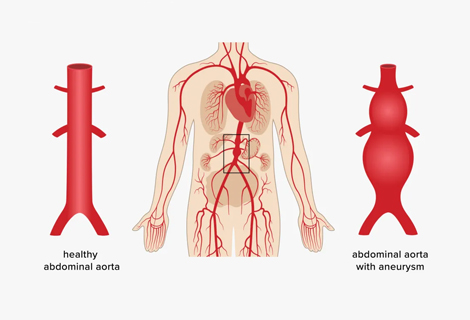Abdominal Aortic Aneurysms
What are Abdominal Aortic Aneurysms?
Aorta is the main blood vessel in the human body that carries blood from the heart to the abdomen, legs, and pelvis. It runs through the chest to the abdomen and splits to move blood to the legs and feet. The aorta's enlargement, bulge, or swelling is known as Abdominal Aortic Aneurysms (AAA).
As the aorta walls become weak, they can swell up like a balloon. When this occurs in the abdomen region aorta, it is called abdominal aortic aneurysms. This can be life-threatening if and only it ruptures. The aneurysm can cause severe bleeding if it breaks open.
What causes Abdominal Aortic Aneurysms?
Most aortic aneurysms occur in the aorta of the abdominal region. The fundamental cause of an aneurysm is unknown, but the risk factors that weaken the aorta walls include:
-
Infection in the aorta
-
Smoking
-
High blood pressure
-
Vascular inflammation
-
Obesity
-
Hardening of arteries
-
Blood vessel diseases
-
High cholesterol
-
Lack of physical activity
-
Over the age of 60
-
Family history of AAA or heart disease
Symptoms of Abdominal Aortic Aneurysms
Not everyone with an abdominal aortic aneurysm will experience symptoms as they often grow slowly over the years. Without any noticeable symptoms, it can be challenging to detect. Small or slow-growing AAA has a lower risk of rupturing than a more prominent or fast-growing AAA.
If you have an aortic aneurysm, you will experience the following symptoms:
-
Constant pain in the abdomen area or side of the belly
-
Persistent lower back
-
Pulse sensation in the belly
A rupture can possibly lead to internal bleeding and life-threatening complications. It can increase the risk of blood clots that break loose and block the blood flow to different body parts. Symptoms that come with a rupture include:
-
Low blood pressure
-
Increased heart rate
-
Severe and persistent pain in abdomen and back
-
Dizziness and fainting
-
Clammy skin
-
Shortness of breath
Diagnosis of Abdominal Aortic Aneurysms
Without any severe symptoms, that is, AAA that has not ruptured, it can be tough to diagnose for AAA. Physicians often detect aortic aneurysms while conducting ultrasound tests for other health conditions.
They will be able to find a lump, rigidness, or a pulsating sensation in the abdomen while examining the patient. Some of the imaging tests recommended by physicians to diagnose abdominal aortic aneurysms include:
-
Abdominal ultrasound
-
Abdominal CT scan
-
Abdominal MRI
-
Chest X-ray
Treatment for Abdominal Aortic Aneurysms
Treatment for Abdominal Aortic Aneurysms depends on the size and severity of the aneurysm. Physicians often recommend medical monitoring if the size is small, slow-growing, and not causing any symptoms. This will require regular checkups and controlling blood pressure and cholesterol.
Physicians would recommend if the aneurysm is larger than 2 inches or if it's rapidly growing. The goal of surgery would be to repair the abdominal aortic aneurysm or remove and replace the damaged aorta. The type of surgery depends on the size, location, patient's health, and AAA type. Treatment options would include:
-
Endovascular surgery
-
Open abdominal surgery



